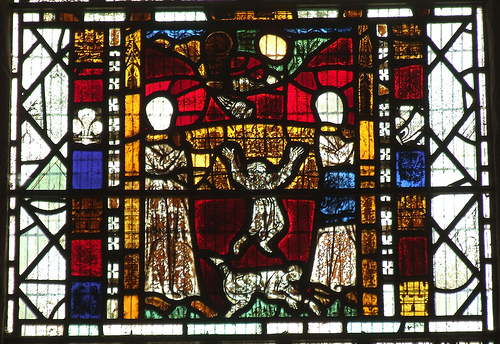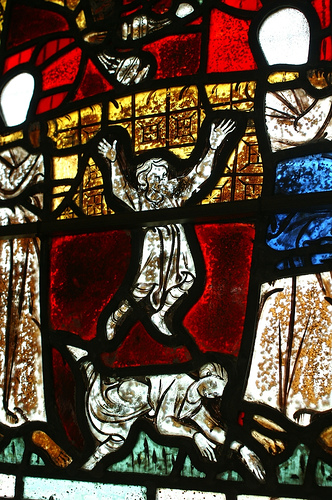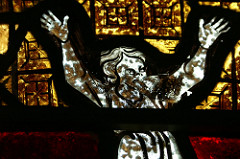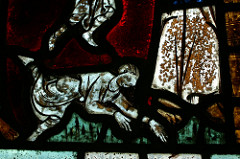The funeral of Our Lady

Photo by Eric Hardy

Stanton St John, Oxfordshire, originally uploaded by Vitrearum.
This panel of late thirteenth century glass at Stanton St John is Oxfordshire is interesting iconographically. It shows an episode from the life of Our Lady, as recorded in the fiftth century apocryphal text 'Transitu Beatae Mariae', which is generally thought to have been writtent by Melito of Sardis. It is in this text that we learn of Our Lady's Dormition and her Assumption. The panel at Stanton portrays the events immediately after Our Lady has fallen asleep and just before her Assumption. The apostles, believing Our Lady to be dead, are carrying her to the tomb in a bier draped with a pall. Here are the events as described in the text:
'And, behold, a new miracle. There appeared above the bier a cloud exceeding great, like the great circle which is wont to appear beside the splendour of the moon; and there was in the clouds an army of angels sending forth a sweet song, and from the sound of the great sweetness the earth resounded. Then the people, baring gone forth from the city, about fifteen thousand, wondered, saying; What is that sound of so great sweetness? Then there stood up one who said to them: Mary has departed from the body, and the disciples of Jesus are singing praises around her. And looking, they saw the couch crowned with great glory, and the apostles singing with a loud voice. And, behold, one of them, who was chief of the priests of the Jews in his rank, filled with fury and rage, said to the rest: Behold, the tabernacle of him who disturbed us and all our race, what glory has it received? And going up, he wished to overturn the bier, and throw the body down to the ground. And immediately his hands dried up from his elbows, and stuck to the couch. And when the apostles raised the bier, part of him hung, and part of him adhered to the couch; and he was vehemently tormented with pain, while the apostles were walking and singing. And the angels who were in the clouds smote the people with blindness.' (Melito of Sardis, The Passing of Blessed Mary).
So here we have the moment when one of the chief priests, trying to tip up the coffin, gets stuck on the bottom of it. We have the angels in the clouds, as described in the text, doing what angels do, i.e. censing. The figure lying on the ground may be one of the people that were struck blind, or does it represent the figure of the priest who has fallen to the ground. I'm sure this curious panel wasn't a stand alone piece, but was part of a larger sequence portraying the life of Our Lady, of which sadly nothing else remains.

- Carnations For Our Lady
South Muskham, Nottinghamshire, originally uploaded by Vitrearum (Allan Barton).As we enter May, the month of Our Lady, here are a group of late medieval quarries decorated with Gillyflowers or Carnations. Carnations were one of a myriad of flowers that...
- Apologies For My Absence
St Michael and All Angels, Louth, Lincolnshire, originally uploaded by Vitrearum.When I last posted on this blog on 19 March I said that I would be absent from the blog for a few weeks. Those few weeks have very quickly turned into nearly three months....
- The Legend Of The Clay Birds
Shorthampton, Oxfordshire, originally uploaded by Vitrearum. This lovely fifteenth century wallpainting at Shorthampton in Oxfordshire, probably represents an episode that is recorded in the second cnetury apocryphal Infancy Gospel of Thomas. In this...
- Workshop Technique - Glass From East Harling, Norfolk
East Harling, Norfolk, originally uploaded by Vitrearum.The east window of the East Harling church contains a considerable amount of late fifteenth century stained glass of the Norwich school. The window is composite, and among the panels are a series...
- Fourteenth Century Wallpainting
South Newington, Oxfordshire, originally uploaded by Vitrearum.South Newington in north Oxfordshire has a superb array of medieval wallpaintings. There is a spectacular series in the north nave aisle dating from the early part of the fourteenth century...
